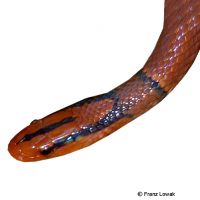Bamboo Snake (Oreocryptophis porphyraceus porphyraceus)
| Bamboo Snake Oreocryptophis porphyraceus porphyraceus | |
|---|---|
| Name | Bamboo Snake |
| Name Lat. | Oreocryptophis porphyraceus porphyraceus |
| Synonym | Elaphe porphyraceus porphyraceus |
| Family | Colubrids |
| Family lat. | Colubridae |
| Order | Scaled Reptiles |
| Order lat. | Squamata |
| Origin | Asia |
| Habitat | Forests |
| Diet | Small mammals |
| Humidity | 70-90 % |
| Behavior | Peaceful |
| Keeping | Individual, pair, group |
| Care Level | Difficult |
| Reproduction | Oviparous |
| Housing | Humid terrarium |
| Life Span | 10-15 years |
| Protection | No |
| Metric Units | |
| Size | 80-90 cm |
| Temperature | 20-25 °C |
| Temperature Local | 27-30 °C |
| Housing Size | 100 x 50 x 100 cm |
| US Units | |
| Size | 31"-35" |
| Temperature | 68-77 °F |
| Temperature Local | 81-86 °F |
| Housing Size | 40" x 20" x 40" |
Distribution and habitat
The distribution area of the mainly crepuscular bamboo snakes is East and Southeast Asia, from India via Indochina to Taiwan. There they prefer to live in higher wooded regions, but also in meadows and bamboo forests near bodies of water.
Maintenance
Minimum dimensions for the terrarium, according to the size and number of animals:
| 1-2 animals | 1KL x 0,5KL x 1KL (L x W x H) |
Body length (KL) is measured on the largest animal. For each additional animal the floor space should be increased by 20%. A terrarium of e.g. L 100 x W 50 x H 100 cm is recommended, which should be placed in a quiet and vibration-free place.
They need a terrarium structured with roots, branched climbing branches, cork tubes and bamboo sticks (hiding places and privacy screen), a moisture-retaining substrate, e.g. of sand-humus mixture with peat and foliage, as well as an easy-to-clean water basin as drinking vessel. A quarter of the substrate must always be kept moist (no waterlogging). Once a day, preferably in the evening, the inside of the terrarium should be finely sprayed with water (humidity). A rain or mist system is ideal.
| Temp. day: 20-25 °C | Temp. night: 17-20 °C | Temp. local: up to 30 °C | Humidity: 70-90 |
Thermostatically controlled floor heating is recommended. Lighting duration must be 12-14 hrs. depending on the season. Daylight fluorescent tubes supplemented with spotlights are ideal.
Diet
The food supply consists of small live rodents (mice, rats, etc.) and nestlings according to their size. After successful acclimatization often succeeds the switch to dead food animals (commercial frozen food). Juveniles should be offered food every 3-5 days, adults every 7-14 days, with occasional periods of fasting (e.g., skipping a feeding). If the snake is disturbed after feeding, this may result in vomiting of the prey. It is better to offer several small feeders, rather than one large one. If it does not eat for a long period of time, both the timing and the food should be varied. It is important to fortify the food animals with vitamins and minerals. Since the snake could be injured by live rodents, it should not be left unattended with them.
Reproduction and breeding
Probing by the veterinarian is the only reliable method of sex determination.
The female lays her eggs (4-7 pieces) in the moist, about 5 cm deep substrate and does not perform brood care. The incubation period is 60-75 days at a temperature of 22-24 °C. The young are 22-25 cm in size and can be fed with nest young mice.
Life expectancy can be 10-15 years.
Important
They are shy and lead a hidden lifestyle. Higher temperatures and too little humidity are not tolerated in the long term
A winter rest of 2-3 months at a temperature of 7-12 °C, accompanied by a feeding break, is recommended.Always have snake hooks and protective gloves ready when handling.The terrarium must have good ventilation without drafts and meet the species-specific needs. Measuring devices such as thermometers, hygrometers, etc. are necessary. The lighting has to correspond to the species-specific day-night rhythm and has to be placed in such a way that the animals cannot injure themselves. The terrarium should be locked in such a way that neither unauthorized persons can open it nor the animals can escape. Contamination must be removed regularly
Further literature can be found in your pet store.
References
Text: Christian Sänger; Image: Franz Lowak
Source: BMELV (1997): Tierschutzgutachten - Mindestanforderungen an die Haltung von Reptilien; ENGELMANN (2006): Zootierhaltung - Tiere in menschlicher Obhut: Reptilien und Amphibien, Harri Deutsch Verlag
- Gemäß § 21 Abs. 5 Tierschutzgesetz idgF
